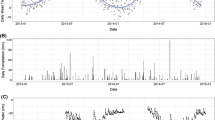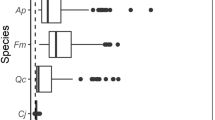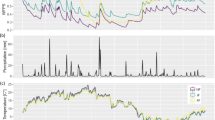Abstract
The stems of living trees in upland forests might contribute to the global methane (CH4) source, but the contribution is poorly understood. We investigated CH4 concentration in the heartwood of living trees in dominant upland forests using field campaign and subsequently evaluated the importance of stem CH4 emission in the context of the global total. We found that only 0%, 9.8%, and 1.8% of stems of living trees had substantial CH4 concentration in heartwood of ≥ 10,000 μL L–1 in the boreal, temperate, and tropical and subtropical upland forests investigated, respectively. CH4 concentration in heartwood depended mainly upon tree species and subsequently soil moisture. Relationships fitted indicate that CH4 concentration followed a power function with respect to water content in heartwood, whereas nitrous oxide (N2O) or carbon dioxide (CO2) concentration linearly increased with water content in heartwood. Stem CH4 emission was estimated at approximately 0.2–2 Tg yr–1 globally, corresponding to less than 0.4% of the global total including all natural plus anthropogenic sources. Water content in heartwood is positively associated with soil water content. Soil water content rarely exceeds 40% v/v in upland forests, indicating stem CH4 emission occurs mainly in the areas of low-lying upland forests with occasionally moist soils. More attentions should be paid on low-lying upland forests and forested wetlands in future when stem CH4 emission needs to be estimated in all forests.
Graphic abstract





Similar content being viewed by others
REFERENCES
Barba J, and others. 2019. Methane emissions from tree stems: a new frontier in the global carbon cycle. New Phytologist 222: 18–28.
Carmichael MJ, Bernhardt ES, Bräuer SL, Smith WK. 2014. The role of vegetation in methane flux to the atmosphere: should vegetation be included as a distinct category in the global methane budget? Biogeochemistry 119:1–24.
Conrad R. 2009. The global methane cycle: recent advances in understanding the microbial processes involved. Environmental Microbiology Reports 1, 285–92.
Covey KR, Wood SA, Warren II RJ, Lee X, Bradford MA. 2012. Elevated methane concentrations in trees of an upland forest. Geophysical Research Letters 39:L15705.
Covey KR, Megonigal JP. 2019. Methane production and emissions in trees and forests. New Phytologist 222: 35–51.
Crowther TW, and others. 2015. Mapping tree density at a global scale. Nature 525:201–5.
Dutaur L, Verchot LV. 2007. A global inventory of the soil CH4 sink. Global Biogeochemical Cycles 21:GB4013.
FAO (Food and Agriculture Organization of the United Nations). 2010. Global forest resources assessment 2010. For. pap. 163, FAO, Rome.
Fei XH, and others. 2018. Carbon exchanges and their responses to temperature and precipitation in forest ecosystems in Yunnan, Southwest China. Science of the Total Environment 616–617:824–40.
Hietala AM, Dörsch P, Kvaalen H, Solheim H. 2015. Carbon dioxide and methane formation in Norway spruce stems infected by white–rot fungi. Forests 6:3304–25.
IPCC, 2013: Summary for Policymakers. In: Climate Change 2013: The Physical Science Basis. Contribution of Working Group I to the Fifth Assessment Report of the Intergovernmental Panel on Climate Change (Stocker TF, Qin D, Plattner GK, Tignor M, Allen SK, Boschung J, Nauels A, Xia Y, Bex V, Midgley PM (eds.)). Cambridge University Press, Cambridge, United Kingdom and New York, NY, USA.
Jia BR, Zhou GS, Jiang YL, Wang Y, Yin XJ, Hu TY. 2013. Temporal-spatial characteristics of soil respiration in Chinese boreal forest ecosystem. Acta Ecologica Sinica 33:7516–24.
Jiang XJ, Liu WJ, Chen CF, Liu JQ, Yuan ZQ, Jin BC, Yu XY. 2018. Effects of three morphometric features of roots on soil water flow behavior in three sites in China. Geoderma 320:161–71.
Li HL, Zhang XM, Deng FD, Han XG, Xiao CW, Han SJ, Wang ZP. 2020. Microbial methane production is affected by secondary metabolites in the heartwood of living trees in upland forests. Trees 34:243–54.
Liu XZ, Wang GA, Li JZ, Wang Q. 2010. Nitrogen isotope composition characteristics of modern plants and their variations along an altitudinal gradient in Dongling Mountain in Beijing. Science China - Earth Science 1:128–40.
Machacova K, Bäck J, Vanhatalo A, Halmeenmäki E, Kolari P, Mammarella I, Pumpanen J, Acosta M, Urban O, Pihlatie M. 2016. Pinus sylvestris as a missing source of nitrous oxide and methane in boreal forest. Scientific Reports 6:23410.
Maier M, Machacova K, Lang F, Svobodova K, Urban O. 2018. Combining soil and tree-stem flux measurements and soil gas profiles to understand CH4 pathways in Fagus sylvatica forests. Journal of Soil Science and Plant Nutrition 181:31–5.
Pitz SL, Megonigal JP. 2017. Temperate forest methane sink diminished by tree emissions. New Phytologist 214:1432–39.
Pitz SL, Megonigal JP, Chang CH, Szlavecz K. 2018. Methane fluxes from tree stems and soils along a habitat gradient. Biogeochemistry 137:307–20.
Plain C, Ndiaye F-K, Bonnaud P, Ranger J, Epron D. 2019. Impact of vegetation on the methane budget of a temperate forest. New Phytologist 221:1447–56.
Sang WG, Su HX, Bai F. 2010. Forest Ecosystems at Beijing Forest Ecosystem Research Station (2000–2006). In: Sun HL, ed. Data collection on the field observation and research of ecosystems in China. Beijing, China, China Agricultural Press.
Saunois M, and others. 2016. The global methane budget 2000–2012. Earth System Science Data 8:697–751.
Shoemaker JK, Keenan TF, Hollinger DY, Richardson AD. 2014. Forest ecosystem changes from annual methane source to sink depending on late summer water balance. Geophysical Research Letters 41:673–9.
Sorz J, Hietz P. 2006. Gas diffusion through wood: implications for oxygen supply. Trees 20:34–41.
Wang ZP, Han XG, Li LH, Chen QS, Duan Y, Cheng WX. 2005. Methane emission from small wetlands and implications for semiarid region budgets. Journal of Geophysical Research 110:D13304.
Wang ZP, Gu Q, Deng FD, Huang JH, Megonigal JP, Yu Q, Lü XT, Li LH, Chang S, Zhang YH, Feng JC, Han XG. 2016. Methane emissions from the trunks of living trees on upland soils. New Phytologist 211:429–39.
Wang ZP, Han SJ, Li HL, Deng FD, Zheng YH, Liu HF, Han XG. 2017. Methane production explained largely by water content in the heartwood of living trees in upland forests. Journal of Geophysical Research: Biogeosciences 122:2479–89.
Ward ND, Indivero J, Gunn C, Wang W, Bailey V, McDowell NG. 2019. Longitudinal gradients in tree stem greenhouse gas concentrations across six Pacific Northwest coastal forests. Journal of Geophysical Research: Biogeosciences 124:1401–12.
Warner DL, Villarreal S, McWilliams K, Inamdar S, Vargas R. 2017. Carbon dioxide and methane fluxes from tree stems, coarse woody debris, and soils in an upland temperate forest. Ecosystems 20:1205–16.
Welch B, Gauci V, Sayer EJ. 2019. Tree stem bases are sources of CH4 and N2O in a tropical forest on upland soil during the dry to wet season transition. Global Change Biology 25:361–72.
Whiting GJ, Chanton JP. 2001. Greenhouse carbon balance of wetlands: methane emission versus carbon sequestration. Tellus 53B:521–28.
Yan GY, Xing YJ, Wang JY, Li ZH, Wang LG, Wang QG, Xu LJ, Zhang Z, Zhang JH, Dong XD, Shan WJ, Guo L, Han S.J. 2018. Sequestration of atmospheric CO2 in boreal forest carbon pools in northeastern China: Effects of nitrogen deposition. Agricultural and Forest Meteorology 248:70–81.
Yuan J, Hui F. 2018. Land use/land cover change and its impacts on protected areas in Mengla County, Xishuangbanna, Southwest China. Environmental Monitoring and Assessment 190: 509.
Zeikus JG, Ward JC. 1974. Methane formation in living trees: a microbial origin. Science 184:1181–83.
ACKNOWLEDGEMENTS
This work was jointly funded by the National Key Research and Development Program of China (2016YFA0600803) and the National Natural Science Foundation of China (31370493, 41930643).
Author information
Authors and Affiliations
Corresponding authors
Ethics declarations
Conflict of interest
The authors declare no conflict of interests.
Additional information
Authors’ Contribution: ZPW, SJH, and XGH conceived the study. ZPW, XMZ, and HHW designed the study. HLL, ZPW, HHW, and JHH performed the research. ZPW, HLL, and HHW analyzed data. ZPW, XMZ, and HHW wrote the manuscript. All authors contributed to the revisions and reviewed the manuscript.
Supplementary Information
Rights and permissions
About this article
Cite this article
Wang, ZP., Li, HL., Wu, HH. et al. Methane Concentration in the Heartwood of Living Trees and Estimated Methane Emission on Stems in Upland Forests. Ecosystems 24, 1485–1499 (2021). https://doi.org/10.1007/s10021-020-00596-3
Received:
Accepted:
Published:
Issue Date:
DOI: https://doi.org/10.1007/s10021-020-00596-3




